Fairytale Floors Castle on the banks of the River Tweed is one of the finest stately homes in all of Scotland. Here, we explore more…
MORE FROM SCOTLAND MAGAZINE
Words by Henrietta Easton
A regular visitor and avid fan of the grand houses of the Scottish Borders, Sir Walter Scott once said of Floors Castle that it was ‘a kingdom fit for Oberon and Titania to dwell in’, and it’s not difficult to see why. Shakespeare’s fairy king and queen, of A Midsummer Night’s Dream, would certainly feel right at home at this magnificent abode, with its distinctive sandstone façade and romantic silhouette, impressive battlements, turrets, and finials, that stands proud on the banks of the River Tweed, near Kelso.
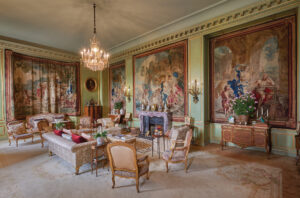
Designed by prominent Scottish architect William Adam between 1721-26 for the 1st Duke of Roxburghe, Floors Castle is the largest inhabited house in Scotland, home to a marvellous collection of decorative furniture, porcelain and fine art, including paintings by Matisse.
Floors was constructed on a natural terrace overlooking beautiful meadowland that sweeps down to where the Teviot meets the River Tweed, and looks directly south across the river to the ruins of the once mighty Roxburgh Castle.
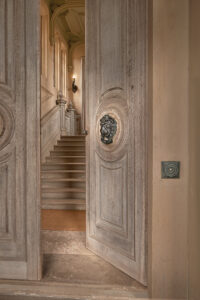
This original Roxburgh Castle, which is now a mere rubble of ruins, was supposedly founded by King David I of Scotland in the early 12th century, but was surrendered to England after the capture of William I at Alnwick in 1174. After that it switched hands between the English and the Scots many times, until 1460 when, after King James II was killed in an explosion during a Scottish siege of Roxburgh, the Scots captured it a final time. On the orders of James’s wife Queen Mary, the castle was destroyed. Thus, supposedly fulfilling a prophecy that said Roxburgh Castle would only fall to a dead man.
Indeed, in the grounds of the castle visitors can see the holly tree where James II was reputedly killed by his exploding canon, and, for those that believe in the supernatural, the apparition of a horseman has allegedly been seen riding towards the site of the castle – could it be the ghost of the king himself?
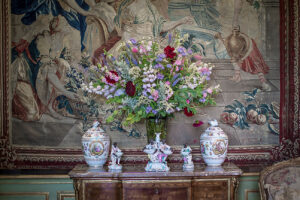
Before the new Floors Castle was built, Broxmouth Park near Dunbar was the main family residence. After 1730, Floors took precedence, with the 1st Duke’s mother leading the way by moving to the house permanently. Although the duke himself spent most of his time in southern England to be close to Parliament, it is said he always cherished his time spent in the country. Just over a century after Adam completed his work, between 1836 and 1847, during the time of the 6th Duke, Edinburgh architect William Henry Playfair was brought in to make changes to the house, considered then to be just a “plain Georgian” house.
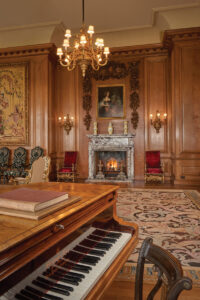
It is Playfair’s work that we see on the exterior of the house today. His changes included significant height added to the structure of the house, and a crowded array of exterior flourishes (inspired by George Heriot’s Hospital in Edinburgh) which gave it its distinctive fairytale silhouette. Playfair also made a change to the coach port which, vitally, would mean that visitors could alight from their carriages sheltered from the elements – an addition we’re sure would be welcome for partygoers not wishing to get their extravagant hairdos and ballgowns wet. He also added two new lodges on the estate, renovated a few 18th-century estate buildings and added a new large walled garden with an extensive suite of glasshouses.
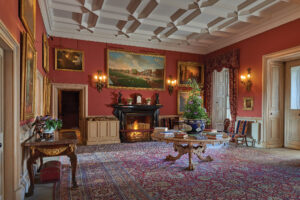
Significant changes were made again to the house in 1903, when the 8th Duke married a wealthy American real estate heiress, by the name of Mary Goelet. It is her remodelling of the house that visitors see during a tour of the castle today. An avid collector of 17th-century tapestries and ornate French furniture, Mary redesigned the Victorian interiors and brought in a treasure trove of artwork, tapestries, porcelain, and furniture.
A must-see during a tour is the unusual bird room which, as the name would suggest, is packed full of around 400 stuffed birds in glass cabinets.
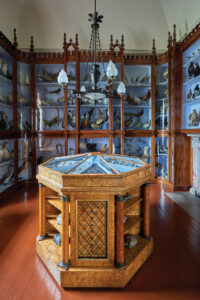
Heading outside, no trip to the castle would be complete without a tour of the gardens. The Victorian Walled Garden is a colourful showpiece that changes with the seasons and includes a delightful kitchen garden – produce grown here is served both in the castle café and sold in the Apple Shed gift shop and deli.
The Millennium Garden, so named as it was created in 2000, is a formal French-style garden with an ‘M’ shaped box hedging at its focal point, and two large letters representing 2000 in Roman numerals. Beneath this are the intertwining initials of the 10th Duke and Duchess of Roxburghe – G, V and R – who built the garden, adding a wonderfully romantic touch to this picture-perfect parterre.
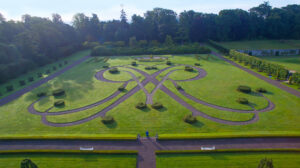
Another highlight of the Millennium Garden is a charming summerhouse known as Queen’s House after Queen Victoria’s visit in 1867, where she is said to have taken tea.
To complete your visit, perhaps after a spot of lunch at the Terrace Café, there are two picturesque trail-marked walks to take that lead from the castle. The woodland walk takes you among giant oaks, beech and chestnut trees (listen and look out for woodpeckers, tawny owls and red squirrels) while the riverside walk is a two-mile circular loop that starts from the castle and follows along the river to the ruins of Roxburgh Castle – a lucky few may even see salmon leaping from the river.
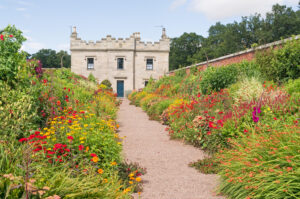
Floors Castle is now run as a modern business, with a wide range of events, a conservation programme, forestry and farming, and sporting pursuits at the forefront of daily life there. The Roxburghe Estate’s family heritage and its longterm investment in the management and sustainability of the estate, aims to safeguard this spectacular house and the beautiful estate it is part of, for future for generations to come.
Undoubtedly the gem of the Scottish Borders, this impressive stately home, for all its history, is so much more than just turrets and tapestries.
This is an extract. Read the full feature in the May/June 2023 issue of Scotland, available to buy from Friday 14 April.
MORE FROM SCOTLAND MAGAZINE

SCOTLAND MAGAZINE
Published six times a year, every issue of Scotland showcases its stunning landscapes and natural beauty, and delves deep into Scottish history. From mysterious clans and famous Scots (both past and present), to the hidden histories of the country’s greatest castles and houses, Scotland‘s pages brim with the soul and secrets of the country.
Scotland magazine captures the spirit of this wild and wonderful nation, explores its history and heritage and recommends great places to visit, so you feel at home here, wherever you are in the world.